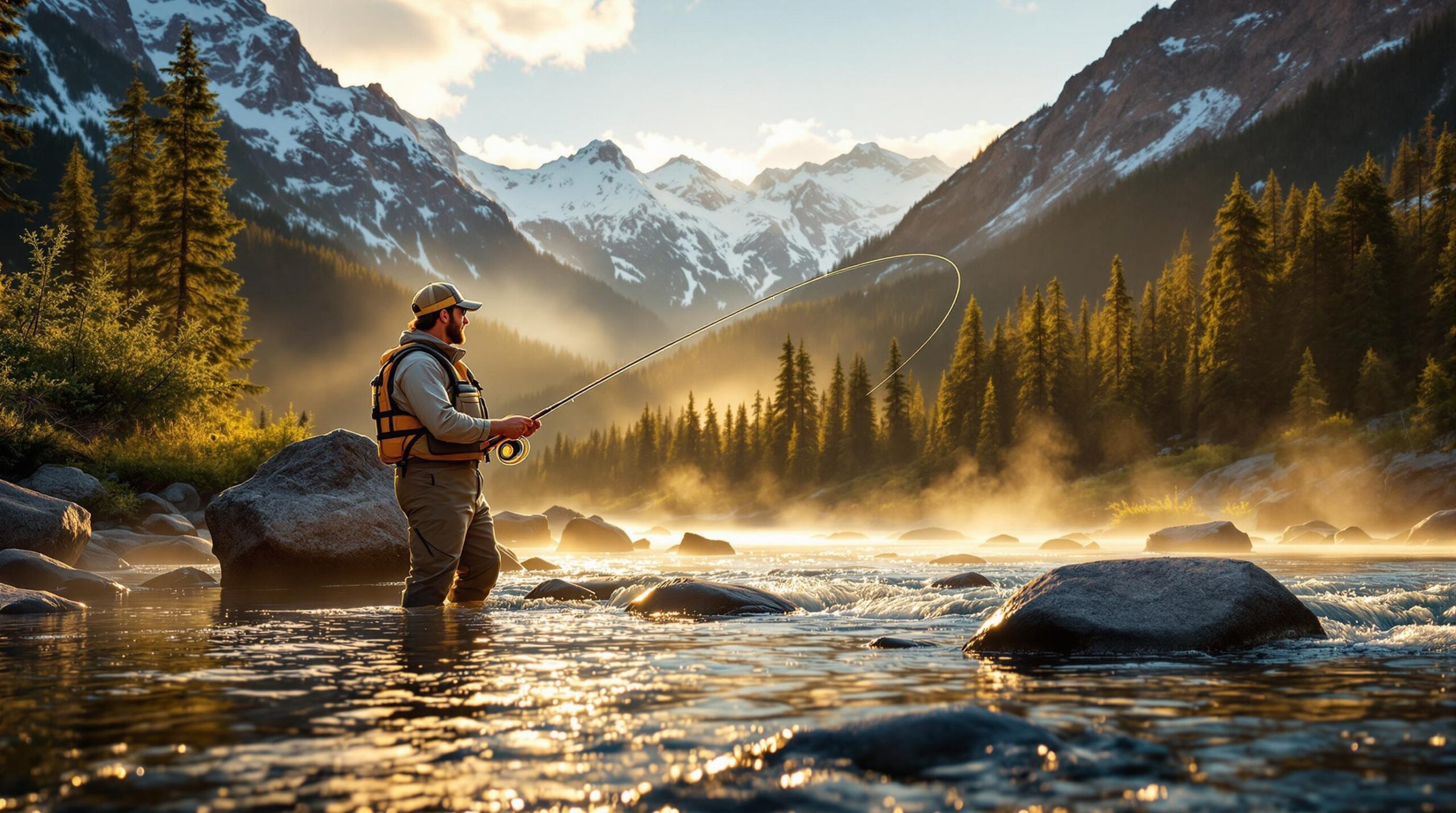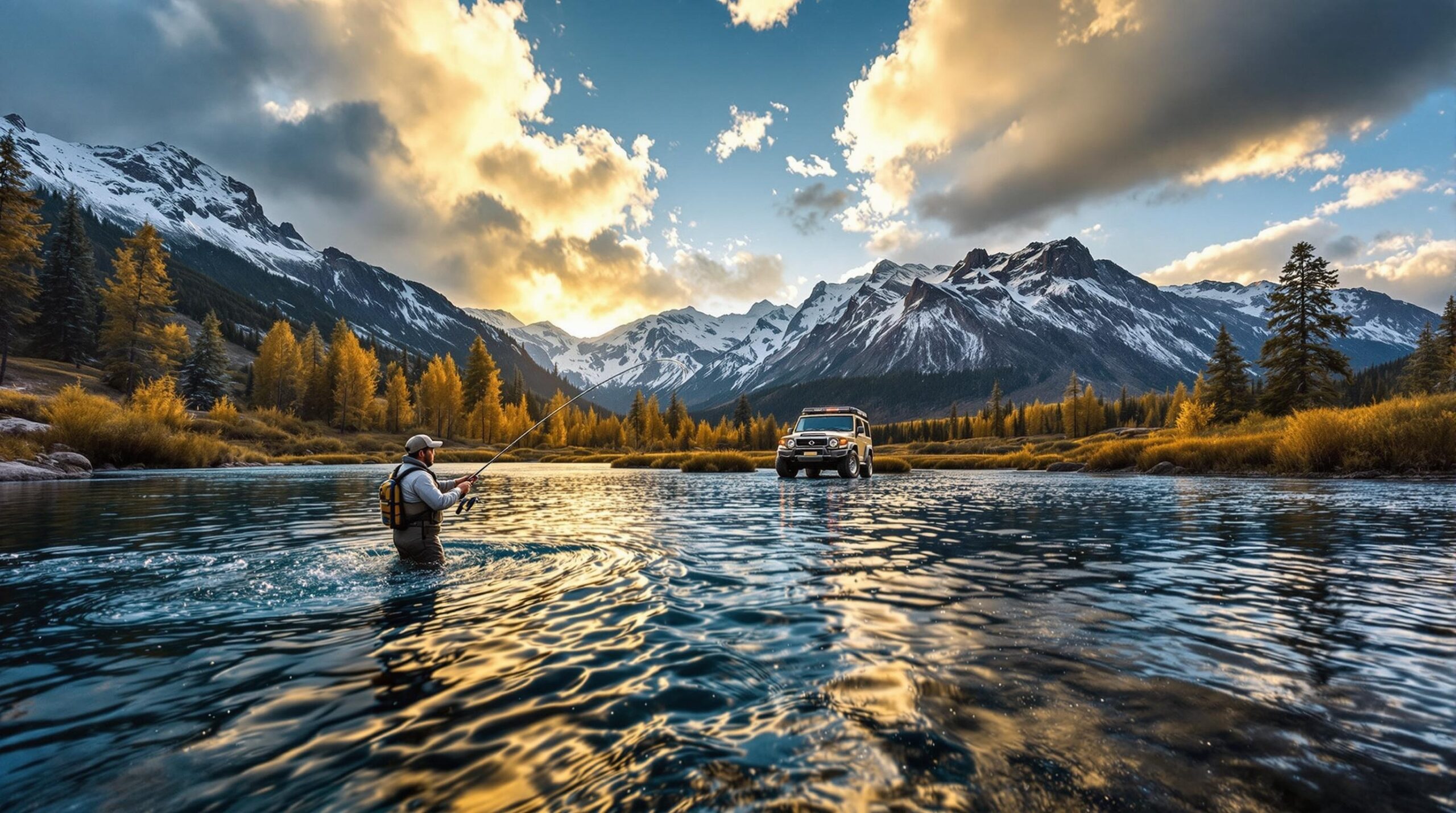According to the American Fly Fishing Trade Association, specialty fly fishing travel bookings increased by 47% in 2023, with the Yellowstone to Sun Valley corridor becoming one of the most sought-after destinations for premium guided fishing experiences. This spectacular 300-mile route connects two of America’s most pristine fishing regions, offering anglers access to legendary waters including the Madison, Gallatin, and Snake Rivers through carefully curated itineraries.
Key Takeaways
- The Yellowstone to Sun Valley route features over 20 world-class fishing destinations within a 300-mile stretch
- Peak fishing season runs from June through September, with different rivers offering optimal conditions at varying times
- Professional outfitters provide guided access to both public waters and exclusive private ranch streams
- Total trip duration ranges from 5-10 days depending on the number of rivers and fishing techniques explored
- Advanced booking is essential as premium accommodations fill 6-8 months ahead during peak season
Planning Your Yellowstone Departure Point
Your adventure begins in the greater Yellowstone ecosystem, where three major river systems converge. The Madison River flows north from Yellowstone National Park, creating the foundation for exceptional fishing experiences.
Most guided trips start from West Yellowstone, Montana, providing immediate access to the Madison’s famous runs. The town serves as a strategic launching point, with outfitters offering everything from single-day excursions to week-long adventures.
Yellowstone’s fishing opportunities include the Firehole River, known for its geothermal influences and unique hatches. The Gibbon River offers intimate small-stream fishing, while the Madison provides classic western freestone experiences.
Essential Route Highlights for Fishing Enthusiasts
Madison River Segment
The Madison River anchors most premium guided experiences departing from Yellowstone. This legendary water stretches 183 miles from its headwaters to Three Forks, Montana.
Between Quake Lake and Ennis, the river offers 50 miles of prime fishing through the Madison Valley. Rainbow and brown trout populations thrive in these nutrient-rich waters, with fish regularly exceeding 20 inches.
Professional guides recommend focusing on the $3 Bridge area and Varney Bridge sections. These stretches provide consistent action throughout the season, making them centerpieces of multi-day itineraries.
Gallatin River Access
The Gallatin River provides a different character than the Madison, flowing through a narrow canyon south of Bozeman. This freestone river demands technical presentations but rewards skilled anglers with native trout.
Guided floats through the Gallatin Canyon offer diverse experiences. The river’s gradient creates varied holding water, from deep pools to technical pocket water behind boulders.
Access points along Highway 191 allow wade fishing opportunities. The Gallatin’s smaller size creates intimate fishing experiences, contrasting with the broader Madison River sections.
Mid-Route Stopover: Bozeman Area Waters
East Gallatin and Hyalite Creek
Bozeman serves as a natural halfway point for extended fishing journeys. The East Gallatin provides spring creek characteristics with consistent flows and technical fishing.
Hyalite Creek offers high-altitude fishing experiences above Bozeman. The creek flows through Hyalite Canyon, providing spectacular scenery alongside productive cutthroat trout fishing.
These smaller waters complement the main river systems, adding variety to multi-day trips. Many outfitters incorporate these “bonus” waters into extended itineraries.
Private Ranch Access
Premium guided experiences include access to private ranch waters around Bozeman. These exclusive fisheries offer pristine conditions with minimal fishing pressure.
The Nelson Spring Creek and DePuy Spring Creek represent world-class private waters. These spring creeks maintain consistent temperatures and flows, supporting exceptional trout populations.
Private water access typically requires advance booking through established outfitters. These exclusive opportunities justify premium pricing for high-end fishing adventures.
Transitioning South: Big Hole Valley
The journey from Yellowstone toward Sun Valley includes the legendary Big Hole River. This pristine river system flows through Montana’s Big Hole Valley, offering some of the West’s finest grayling and trout fishing.
The Big Hole maintains its wild character, with minimal development along its banks. Arctic grayling populations, rare in the lower 48 states, provide unique angling opportunities.
Melrose and Twin Bridges provide access to different river sections. The upper river near Jackson offers intimate small-stream fishing, while lower sections provide classic western freestone experiences.
Snake River System: Idaho’s Crown Jewel
Henry’s Fork Inclusion
No trip covering this route should omit the Henry’s Fork. This technically demanding river tests even experienced anglers with its gin-clear water and educated trout.
The Railroad Ranch section represents one of America’s most challenging spring creek fisheries. Dry fly fishing here requires precise presentations and perfect drag-free drifts.
Last Chance provides easier access for anglers new to Henry’s Fork fishing. This section offers good hatches and more forgiving conditions while maintaining the river’s legendary reputation.
Main Snake River Fishing
Idaho’s fishing opportunities include the main Snake River below Palisades Dam. This large river supports significant cutthroat trout populations and offers excellent streamer fishing.
The Snake River’s size allows multiple fishing techniques within single trips. Dry flies work during hatches, while streamers produce throughout the season.
Float trips cover significant water efficiently. Professional guides know productive runs and can position anglers for optimal presentations in varying water conditions.
Sun Valley: The Ultimate Destination
Big Wood River System
Sun Valley anchors the southern terminus for premium fishing adventures. The Big Wood River flows through this famous resort area, providing easily accessible fishing.
The river supports wild rainbow and brown trout populations. Urban sections through Ketchum and Sun Valley offer convenient fishing between other activities.
Upstream sections toward Galena Summit provide more wilderness-like experiences. These higher elevation areas typically fish best later in the season as snowpack diminishes.
Silver Creek Access
Silver Creek represents one of Idaho’s premier spring creek fisheries. Located south of Sun Valley, this technical fishery challenges even expert anglers.
The Nature Conservancy manages Silver Creek, maintaining habitat quality and fishing access. Special regulations protect this unique ecosystem and its exceptional trout populations.
Many fishing journeys conclude with Silver Creek experiences. The creek’s technical demands provide fitting challenges for anglers who’ve developed skills throughout their journey.
Seasonal Considerations for Your Fishing Adventure
Spring Conditions (May-June)
Early season trips focus on lower elevation rivers and spring creeks. Runoff affects many freestone rivers, limiting fishing opportunities.
The Henry’s Fork and Silver Creek provide consistent fishing during runoff periods. These spring-fed systems maintain clarity when other rivers run high and muddy.
Streamer fishing excels during high water periods. Large flies moved aggressively can produce exceptional results when traditional dry fly and nymph fishing proves difficult.
Summer Peak Season (July-August)
Peak summer represents optimal conditions for multi-day fishing adventures. All major rivers typically fish well during this period.
Hatch activity peaks during summer months. Pale Morning Dun, Caddis, and various mayfly hatches provide consistent dry fly opportunities.
Higher elevation waters become accessible as snowpack recedes. Alpine lakes and high mountain streams expand available fishing options for extended trips.
Fall Fishing (September-October)
Autumn fishing adventures offer spectacular scenery alongside excellent fishing. Brown trout spawning runs begin, creating exciting streamer fishing opportunities.
Cooler temperatures concentrate fish in predictable locations. Large browns move into tributaries, providing target-rich environments for trophy hunters.
Fall conditions often produce the year’s largest fish. Aggressive pre-spawn feeding makes this season particularly attractive for experienced anglers.
Accommodation Options for Your Journey
Luxury Lodge Experiences
High-end fishing adventures feature luxury fishing lodges along the route. These accommodations provide services including meals, guides, and equipment.
The Madison Valley Ranch offers exclusive access to private waters alongside luxury accommodations. Guest capacity remains limited, ensuring personalized service and uncrowded fishing.
Sun Valley Lodge provides world-class accommodations at the route’s terminus. The historic lodge combines luxury amenities with easy access to local fishing opportunities.
Rustic Ranch Settings
Working ranch accommodations provide authentic western experiences. These properties offer comfortable lodging alongside genuine ranch activities.
The Big Hole Lodge operates as a working cattle ranch while hosting fishing guests. Visitors experience authentic ranch life between fishing excursions.
Ranch-based trips often include horseback access to remote fishing locations. This traditional approach reaches waters inaccessible by vehicle, adding adventure elements to fishing experiences.
Camping and RV Options
Budget-conscious fishing trips incorporate camping and RV accommodations. Public campgrounds provide access to prime fishing areas at reasonable costs.
Private RV parks near major rivers cater to fishing-focused travelers. These facilities typically offer enhanced amenities while maintaining proximity to productive waters.
Backcountry camping opens access to pristine alpine fishing experiences. Lightweight backpacking gear allows multi-day excursions to remote mountain lakes and streams.
Equipment and Preparation Essentials
Rod and Reel Specifications
Multi-day fishing adventures require versatile equipment selections. A 9-foot 5-weight rod handles most situations encountered along this route.
Supplementary 4-weight and 6-weight rods expand technique options. Lighter rods excel on technical spring creeks, while heavier rods manage large rivers and windy conditions.
Quality reels with reliable drag systems prove essential for large trout. Disc drag reels handle powerful runs from trophy-sized fish encountered in these premier waters.
Fly Selection Strategy
Successful fishing trips require varied fly selections covering diverse water types. Standard western patterns form the foundation of effective fly boxes.
Dry flies should include Adams, Elk Hair Caddis, and Pale Morning Duns in multiple sizes. These patterns cover the majority of surface feeding situations encountered.
Nymph selections must include Pheasant Tails, Hare’s Ears, and Prince Nymphs. Bead-head versions provide necessary weight for deeper presentations.
Streamer patterns like Woolly Buggers and Zonkers produce consistently throughout the route. Larger streamers work well for trophy hunting, particularly during fall conditions.
Professional Guide Services and Instruction
Local Knowledge Benefits
Professional guides provide invaluable local knowledge. Their understanding of current conditions, hatches, and fish behavior significantly improves success rates.
Guide services adapt to changing conditions throughout multi-day trips. Water level fluctuations, weather changes, and seasonal variations require constant strategy adjustments.
Yellowstone area guides possess permits for exclusive water access. Many prime locations require special use permits only available through licensed outfitters.
Skill Development Components
Educational fishing adventures incorporate instruction alongside guided fishing. Progressive skill development improves both immediate and long-term angling success.
Casting instruction addresses technique refinements specific to different water types. Spring creek presentations differ significantly from freestone river approaches.
Entomology education improves hatch matching abilities. Understanding insect life cycles and behavior patterns leads to better fly selection and presentation strategies.
Reading water skills development helps anglers identify productive locations independently. This knowledge proves valuable beyond guided portions of fishing trips.
Transportation and Logistics Planning
Vehicle Requirements
Self-drive fishing adventures require reliable four-wheel-drive vehicles. Many productive fishing locations involve rough access roads unsuitable for standard passenger cars.
Rental options in gateway cities provide appropriate vehicles for fishing-focused travel. Local rental agencies often stock pickup trucks and SUVs specifically for outdoor recreation access.
Storage capacity becomes crucial for extended trips. Fishing equipment, luggage, and camping gear require significant vehicle space for comfortable travel.
Alternative Transportation
Full-service fishing adventures provide transportation as part of their offerings. Professional drivers familiar with local roads ensure safe, efficient travel between fishing locations.
Helicopter access opens remote fishing opportunities unavailable through ground transportation. Alpine lakes and backcountry streams become accessible for unique fishing experiences.
Float plane services reach isolated waters in wilderness areas. These specialized transportation options create truly exclusive fishing experiences.
Cost Considerations and Pricing
Budget-Friendly Options
Basic fishing trips focus on public water access and standard accommodations. These options provide excellent fishing experiences while controlling costs.
Self-guided trips eliminate guide expenses while maintaining access to prime fishing locations. Detailed route information and local contacts support independent anglers.
Group trips reduce per-person costs through shared accommodations and transportation. Fishing clubs and organized groups often receive significant discounts from outfitters.
Premium Experience Pricing
Luxury fishing adventures command premium pricing for exclusive access and services. Private water access, luxury accommodations, and personalized guide services justify higher costs.
All-inclusive trips simplify budgeting by covering accommodations, meals, guides, and transportation. These offerings eliminate unexpected expenses during travel.
Extended trips spanning 7-10 days provide better per-day value than shorter excursions. Fixed costs like transportation and guide setup fees distribute across more fishing days.
Best Times to Book Your Adventure
Advance Reservation Requirements
Premium fishing adventures require 6-8 months advance booking for peak season dates. Popular lodges and guide services fill early, particularly for July and August slots.
Spring booking for summer trips often provides better selection and pricing. Early reservations secure preferred dates and accommodations before prime options disappear.
Cancellation policies vary significantly between providers. Understanding refund and rescheduling terms prevents potential losses due to unexpected changes.
Last-Minute Opportunities
Cancellation-based availability sometimes creates last-minute openings in popular fishing adventures. Flexible travelers can capitalize on these opportunities for significant savings.
Shoulder season trips offer reduced pricing with comparable fishing quality. Late May, early June, and September dates often provide excellent value.
Weather-dependent cancellations create short-notice availability. Monitoring outfitter websites and maintaining flexibility can yield exceptional last-minute deals.
Photography and Memory Preservation
Professional Photography Services
Many premium fishing adventures include professional photography services. Dedicated photographers capture both fishing action and scenic beauty throughout the journey.
Underwater cameras document catch and release moments while protecting fish welfare. These specialized tools create unique perspectives unavailable through traditional photography.
Drone photography captures spectacular aerial views of fishing locations. These images provide context and scale impossible to achieve from ground level.
Personal Documentation Strategies
Waterproof camera equipment proves essential for personal documentation during fishing trips. Action cameras provide hands-free recording capabilities during active fishing.
Digital organization systems help manage large photo volumes from extended trips. Cloud storage ensures backup protection for irreplaceable fishing memories.
Social media sharing improves trip experiences while promoting conservation awareness. Responsible sharing educates others about catch and release practices and habitat protection.
Conservation and Ethical Considerations
Catch and Release Practices
Responsible fishing adventures emphasize proper catch and release techniques. These practices ensure fishery sustainability for future generations of anglers.
Barbless hooks and proper handling techniques minimize fish stress during capture and release. Quick photography and gentle handling preserve fish health and survival rates.
Water temperature monitoring guides fishing decisions during warm weather periods. Elevated temperatures increase fish stress, sometimes requiring fishing moratorium periods.
Leave No Trace Principles
Environmental stewardship forms a core component of ethical fishing adventures. Leave No Trace principles guide all activities throughout fishing journeys.
Pack out all waste including fishing line, leaders, and food containers. Even biodegradable materials can negatively impact pristine environments when left behind.
Stay on established trails and use designated camping areas when available. Minimizing environmental impact preserves fishing locations for future visitors.
Respect wildlife encounters by maintaining appropriate distances. Fishing areas often support diverse wildlife populations requiring careful coexistence strategies.
FAQ
What’s the optimal duration for Yellowstone to Sun Valley fishing trips?
Most trips range from 7-10 days, allowing adequate time to fish major rivers while accounting for travel and weather contingencies.
When is the best time to book fishing adventures for this route?
Book 6-8 months in advance for peak season (July-August). Spring bookings offer better selection and sometimes early bird pricing discounts.
Do I need a 4-wheel drive vehicle for accessing fishing locations?
While not always required, 4WD significantly improves access to remote fishing spots and provides safety margins on rough approach roads.
What fishing license requirements apply across state boundaries?
You’ll need separate licenses for Montana and Idaho. Consider purchasing annual licenses if planning multiple trips or extended stays.
Can beginners participate in these fishing adventures?
Yes, many trips accommodate all skill levels with appropriate guide instruction and water selection matching angler experience levels.
What’s included in typical all-inclusive fishing trips?
Most include lodging, meals, professional guides, transportation between locations, and basic fishing equipment. Check specific inclusions carefully.
Sources:
American Sportfishing Association
Montana Fish, Wildlife & Parks
Idaho Department of Commerce
Trout Unlimited
U.S. Geological Survey
Travel Montana
Yellowstone Country Tourism
Henry’s Fork Foundation
Jackson Hole Travel
Orvis Travel


